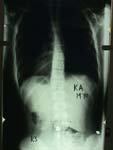 Observation is appropriate for small curves, curves that are at low risk of progression, and those with a natural history that is favorable at the completion of growth. These decisions are based on the expected natural history of a given curve. For example, if your child is diagnosed with a curve of 25 to 40 degrees and has completed growth (i.e., boys older than 17, girls older than 15), then observation is appropriate. Statistically, these curves are at low risk of progression and are not likely to cause problems in adulthood. Follow-up x-ray once per year for several years would then confirm that the curve is not progressing after completion of growth. As an adult, an x-ray every five years, or if there are symptoms, is sufficient.
Observation is appropriate for small curves, curves that are at low risk of progression, and those with a natural history that is favorable at the completion of growth. These decisions are based on the expected natural history of a given curve. For example, if your child is diagnosed with a curve of 25 to 40 degrees and has completed growth (i.e., boys older than 17, girls older than 15), then observation is appropriate. Statistically, these curves are at low risk of progression and are not likely to cause problems in adulthood. Follow-up x-ray once per year for several years would then confirm that the curve is not progressing after completion of growth. As an adult, an x-ray every five years, or if there are symptoms, is sufficient.
This 14-year-old female presented from school screening with a 14-degree right thoracic scoliosis. She had begun menstrual periods over a year ago and was risser 3 in terms of skeletal maturity. The provider’s recommendation was observation, since the likelihood that her curve would progress was low.
 This is a three-year-old male with a complex pattern of congenital anomalies of the spine, including multiple hemivertebra and a failure of segmentation on the convex side of the curve. This curve has a significant risk of further progression. However, no intervention was recommended at this point.
This is a three-year-old male with a complex pattern of congenital anomalies of the spine, including multiple hemivertebra and a failure of segmentation on the convex side of the curve. This curve has a significant risk of further progression. However, no intervention was recommended at this point.

